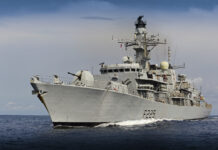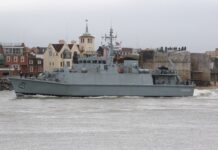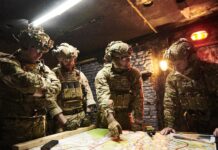Babcock has delivered Type 23 frigate HMS St Albans back to the Royal Navy for sea trials three months ahead of the planned schedule following the completion of its life extension (LIFEX) programme, the company announced on 7 March 2024.
Once the ship’s current sea trials are completed, HMS St Albans, with a 178-strong crew, will return to sea as the most advanced, equipped and capable Type 23 frigate in the Royal Navy fleet, featuring next-generation weapon systems and radar.
During HMS St Albans’ time in dock, Babcock engineers and other tradespeople spent around 1.2 million working hours carrying out a significant number of upgrades to keep the ship at the leading edge of warfighting capability, including a substantial power generation and machinery upgrade; the removal, overhaul and replacement of both propulsion motors; and finally stripping and repainting the ship’s entire hull.
Crew facilities have also been improved and modernised to support the personnel living on board.
Gary Simpson, managing director of Babcock’s Marine Support business, was quoted as saying in a company press release, “Working on behalf of DE&S [the UK Ministry of Defence’s Defence Equipment & Support organisation], preparing HMS St Albans for sea again is central to ensuring our customer’s critical services are readily available, affordable, and long-lasting.
“Our skilled teams of engineers, fabricators, technicians, and other experts, with the support of DE&S, the Royal Navy and specialists in our supply chain, worked tirelessly to ensure the complex and extensive refit of HMS St Albans was a resounding success. Watching her leave for sea trials was a proud moment for everyone involved.”
The commanding officer of HMS St Albans, Commander Helen Coxon, was quoted as stating: “Going back to sea is a huge milestone and the result of a real team effort where Ship’s Company, DE&S, Babcock and other specialist contractors have come together to help us transition from engineering project back to being a warship.
“Whether it was the first day at sea – as was the case for many of our less experienced sailors – or returning back to where we feel at home for the more experienced, sailing from Devonport was a big day and we’d like to thank all those involved in making it happen.”
Type 23 frigates entered Royal Navy service in 1989. They will ultimately be replaced by Type 26 Global Combat Ships, which are not set to enter service until later this decade, meaning that the Type 23 fleet is having to operate well beyond its original design life. The LIFEX programme for the class therefore began in 2014, which involves a hull survey and repairs, the Sea Wolf air defence missile system replaced with the Sea Ceptor system, a new Type 997 Artisan 3D radar (if not already fitted) and a wide range of other upgrades and refurbishments.
For the anti-submarine warfare (ASW) role the ships’ bow-mounted Type 2050 sonar system is replaced by the next-generation Type 2150 system, while the eight newer Type 23s also receive the Sonar 2087 towed-array ASW system.
HMS St Albans is the penultimate Type 23 to receive the LIFEX; HMS Sutherland is still in refit and is due to be returned to service in June 2024.
A post-life extension upkeep programme for the Type 23s has also been initiated, which began with HMS Argyll in the summer of 2022.













